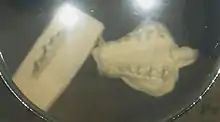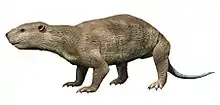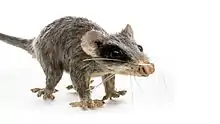| Deltatheridiidae Temporal range: Early Cretaceous-Paleocene | |
|---|---|
 | |
| Deltatheridium praetrituberculare | |
| Scientific classification | |
| Domain: | Eukaryota |
| Kingdom: | Animalia |
| Phylum: | Chordata |
| Class: | Mammalia |
| Order: | †Deltatheroida |
| Family: | †Deltatheridiidae Gregory & Simpson, 1926 |
| Type genus | |
| Deltatheridium Gregory & Simpson, 1926 | |
| Genera | |
|
See text | |
| Synonyms | |
| |
Deltatheridiidae is an extinct family of basal carnivorous metatherians that lived in the Cretaceous and were closely related to marsupials. Their fossils are restricted to Central Asia (Mongolia and Uzbekistan) and North America (United States - Oklahoma, Texas, Utah, Wyoming). They mostly disappeared in the KT event, but a ghost lineage, currently represented by Gurbanodelta, survived until the late Paleocene by decreasing in size and becoming insectivorous.[1]
The family consist in six genera:[2][3][4][5]
- Atokatheridium Kielan-Jaworowska & Cifelli, 2001
- Deltatheridium Gregory & Simpson, 1926
- Deltatheroides Gregory & Simpson, 1926
- Gurbanodelta X. Ni et al. 2016
- Lotheridium S. Bi et al. 2015
- Oklatheridium Davis, Cifelli & Kielan-Jaworowska, 2008
- Nanocuris Fox, Scott & Bryant, 2007
- Sulestes Nessov, 1985
- Tsagandelta G. W. Rougier et al. 2015
References
- ↑ Xijun Ni; Qiang Li; Thomas A. Stidham; Lüzhou Li; Xiaoyu Lu; Jin Meng (2016). "A late Paleocene probable metatherian (?deltatheroidan) survivor of the Cretaceous mass extinction". Scientific Reports. 6: Article number 38547. doi:10.1038/srep38547.
- ↑ B. M. Davis, R. L. Cifelli, and Z. Kielan-Jaworowska. 2008. 1. Earliest Evidence of Deltatheroida (Mammalia: Metatheria) from the Early Cretaceous of North America. Mammalian Evolutionary Morphology: A Tribute to Frederick S. Szalay 3-24
- ↑ G. P. Wilson and J. A. Riedel. 2010. New specimen reveals deltatheroidan affinities of the North American Late Cretaceous mammal Nanocuris. Journal of Vertebrate Paleontology 30(3):872-884
- ↑ B. M. Davis and R. L. Cifelli. 2011. Reappraisal of the tribosphenidan mammals from the Trinity Group (Aptian-Albian) of Texas and Oklahoma. Acta Palaeontologica Polonica 56(3):441-462
- ↑ Xijun Ni; Qiang Li; Thomas A. Stidham; Lüzhou Li; Xiaoyu Lu; Jin Meng (2016). "A late Paleocene probable metatherian (?deltatheroidan) survivor of the Cretaceous mass extinction". Scientific Reports. 6: Article number 38547. doi:10.1038/srep38547.
This article is issued from Wikipedia. The text is licensed under Creative Commons - Attribution - Sharealike. Additional terms may apply for the media files.



